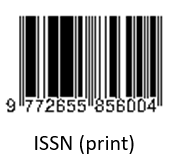Evolution of The Generalized Coordinates of Pendulum-Spring System
(1) Universitas PGRI Semarang
(2)
(*) Corresponding Author
Abstract
The pendulum-spring system studied using Hamilton equations consists of three generalized coordinates. The coordinates are the swing angle of the rod, the swing angle of the spring, and the length extension. In this case, the total Hamiltonian is complicated because of the complicated mechanical system. Six equations of motion are obtained from the Hamilton equations. The visualization of the generalized coordinates with respect to time is illustrated. In the visualization, the spring constant and the initial swing angle of the rod were varied. These variations obtained the harmonic and non-harmonic motion. The motion of such a complex system was usually sensitive to the initial values. Solving the mechanical problems with Hamiltonian formalism could familiarize students with a branch of physics with numerous indispensable applications to other branches.
Full Text:
PDFReferences
P. Mann,, Lagrangian adn Hamiltonian Dynamics, Oxford Academic
(2018).
C.G Weaver, Hamiltonian, Hamiltonian Mechanics, and Causation, Illinois:
University of Illiniois at Urbana-Champaign, (2020).
N.W. Rini, J. Saefan, N. Khoiri, Lagrangian Equation of Coupled Spring-
Pendulum System, Physics Communication, 7(1) (2023) 22-27.
Palka, L., Schauer, F., and Dostal, P., Modelling of the simple pendulum Experiment,MATEC Web of Conferences, 76(1) (2016).
E. Yazid, Mathematical Modeling of A Moving Planar Payload Pendulum On
Flexible Portal Framework, Journal of Mechatronics, Electrical Power, and Vehicular Technology, 2(2) (2011) 95-104.
H. Biglari and A.R. Jami, The Double Pendulum Numerical Analysis wit Lagrangian and Hamiltonian Equations of motions, Conference: International Conference on Mechanical and Aerospace Engineering, (2016).
T. Stachowiak and T. Okada, A Numerical Analysis of Chaos in the Double Pendulum, Journal: Chaos, Solitons, and Fractlas, 29(2) (2006) 417-422.
I. Indiati, J. Saefan, and P. Marwoto, Numerical Approach of Hamilton Equations on Double Pendulum Motion with Axial Forcing Constraint, Journal of Physics: Conference Series,(2016).
P. Hamill, A Student’s Guide to Lagrangians and Hamiltonians, United Kingdom: Cambridge University Press, (2014).
A. Elbori, and L. Abdalsmd, Simulation of Double Pendulum, Quest Journals Journal of Software Engineering and Simulation, 3(7) (2017) 1-13.
S. D’Alessio, An analytical, numerical and experimental study of the double pendulum, European Journal of Physics, (44) (2023) 1-20.
Esp´,R. Espindola1, G. Del Va, G. He´rnanandez, I. Pined, D. Mu˜cianos,D ı´az6, P., Guijosa, and S., The Double Pendulum of Variable Mass: Numerical Study for different cases, IOP Conf. Series: Journal of Physics: Conf. Series, 1221 (2019).
Andres Lorente, Dynamic Characteristics of Pendulum System, master’s thesis, Blekinge Institute of Technology, Sweden, (2010).
DOI: https://doi.org/10.24071/ijasst.v5i2.6336
Refbacks
- There are currently no refbacks.
Publisher : Faculty of Science and Technology
Society/Institution : Sanata Dharma University

This work is licensed under a Creative Commons Attribution 4.0 International License.











